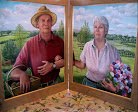Leipzig
Last year my wife Marty and I visited Leipzig, not far from our companion Lutheran diocese of Anhalt. Within the inner ring road, built over the medieval city walls, the compact historic centre is being lovingly restored after decades of neglect in the former East Germany. One of its jewels is the Nikolaikirche – St Nicholas’ Church - where Johann Sebastian Bach’s Johannes Passion was first performed on Good Friday of 1724. There we first learned of the amazing role this beautiful 12th century church played in the events of 20 years ago, leading up to the fall of the Berlin Wall. Derek Scally wrote a fine article about it in the Irish Times on 7th October (you can find it by googling ‘Derek Scally Leipzig’).
Pastor Christian Führer
Pastor Christian Führer, now retired
The long road to 1989 began in 1981 with peace prayer evenings organised by Nikolaikirche’s pastor Christian Führer in 1981 in response to the Cold War arms race. Five years on, the Monday night gatherings were attracting just four people. Pastor Christian recalls, “I was ready to give up but one of the people attending said, ‘If we give up, then there is no hope any more’. Then I remembered the parable of the mustard seed, the smallest of all seeds that can still grow to provide shelter for many.” He carried on with the prayer evenings.
By 1988 the era of perestroika had come to the Soviet Union, and in East Berlin, the elderly Politburo was in denial about the need for reforms. In Leipzig, Pastor Christian could sense the longing for change. “The people had been silenced, by fear and the secret police, we provided a space for them to discuss taboo topics,” he says. Attendance at his Monday prayer meetings grew – from eight to 80, and then 100. On September 4th a group of young people emerged from the Monday meeting to hold up a banner reading: “For an open life with free people.” A Stasi agent ran forward to snatch the banner, filmed by a West German TV crew, with the footage seen in East as well as West Germany. A week later, the Nikolaikirche was full. Pastor Christian was jubilant but nervous: would the meetings remain calm as the pressure continued to build? “I reminded people of the Sermon on the Mount – love your enemy – and hoped they would take this message of non-violence with them from the church.”
The critical turning point came in October 1989. As East Germany approached its fortieth anniversary on October 6th, the regime was becoming more and more anxious to calm a situation which was out of control. Thousands of its citizens were escaping across the Czech border to Hungary, which had opened its borders to the West, and attempts to stop this resulted in more angry protests and police using water cannons and batons to drive back the crowds.
9th October 1989
The mood in Leipzig before the next Monday prayers on 9th October was increasingly tense. Pastor Christian urged three other inner-city churches to open their doors for prayers, so that as many people as possible would be inside, protected from the police. Local dignitaries, including the director of the Leipzig Philharmonic Orchestra and the area bishop, appealed for non-violence. Thousands of ordinary people left their homes, said goodbye to children and partners, and converged upon the city centre. Eye-witnesses tell of the turmoil of emotions they felt: terror, as they wondered if they would return home, mixed with determination, arising out of the despair of knowing that if they stayed at home nothing would ever change. The church was filled, with many Stasi agents as well as protestors.
Pastor Christian describes what happened as the service ended, “More than 2,000 people leaving the church were welcomed by tens of thousands waiting outside with candles in their hands. I will never forget this moment. A person needs two hands to carry a candle: one to hold it and the other to protect the flame – so you can’t carry sticks or stones at the same time. The miracle happened. Jesus’ spirit of non-violence seized the masses and transformed them into a real and peaceful, powerful presence. Troops and police officers were drawn in and became engaged in conversations. The crowds chanted ‘Keine Gewalt!’ – ‘No violence!’ - and the police withdrew.”

In giving me permission to quote from his article, Derek Scally has this to say, “It was a huge honour to talk to the people from the Nikolaikirche. Many of them told me they still remembered clearly their anxiety from the evening, that they were walking into a second Tiananmen Square. Too little is known of the key role of the religious in the 1989 events.”
Prayer is action
This is a remarkable story that can truly inspire us. It shows that prayer can be powerful action. Out of a tiny mustard seed of prayer, a peaceful revolution was born. Some were in Nikolaikirche to spy, some half-listening, some cynical, some committed, some believers, many unsure. But prayer and action became one as they came together. Prayer is like a pebble in the pond, sending ripples far and wide – or like the steady drip which gradually wears away the stone. We too can plant a mustard seed!


No comments:
Post a Comment